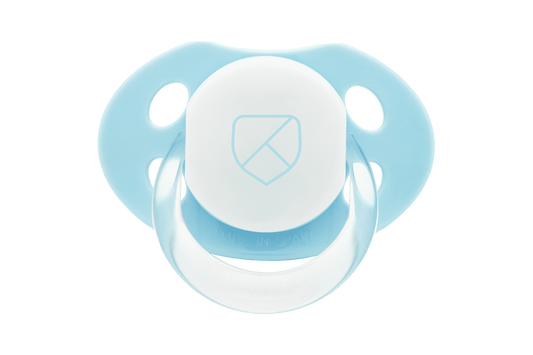A dummy can help young infants settle before bedtime or soothe them when under stress, such as when separated from their mum. This is why so many babies end up becoming inseparable from their dummy... and why mums and dads struggle to wean their children off it.
We often hear many parents asking how they can ditch the dummy using the Montessori approach; however, Montessori believed babies should ideally not use a dummy at all. If, however, we reformulate the question by asking how to wean a child off a dummy whilst respecting their needs, then we can find an answer.
However, before moving on to how, let's focus for a moment on when: around what age should your child ditch their dummy?
When to get rid of the dummy
Some say the sooner the better. The idea behind this statement is that, when a baby is very young - under 12 months of age - they don’t need any explanation or to enter in a negotiation to convince them to stop using their dummy. By simply taking it away from them, they’ll more than likely forget about it completely in just a few days.
Others, on the contrary, feel it’s best to wait until the child feels ready to give up their dummy: it may seem unthinkable to you at the moment, but sooner or later the time will come when your little one will tire of their dummy and just stop using it.
It’s important to know that experts suggest that your child should be fully weaned off their dummy no later than three or four years old. A child at this age has enough self-confidence and is also able to find other ways to soothe themselves. Timing, however, is key; periods of change or stress are not the best times to start weaning your child off their dummy, such as the birth of a sibling or the start of nursery school.
What problems can long-term dummy use cause?
Four years old is considered the age limit for using a dummy, after that it is much more likely to cause problems such as:
- Deformation of the palate or dental arch.
- Increased frequency of ear infections, as well as nose and throat infections, due to the tendency to breathe through their mouth rather than their nose.
- Delayed or impaired speech development, as a dummy hinders the full range of tongue and lip movements and also acts as a deterrent for a child to communicate through sounds, babbling or speech.
How to ditch the dummy: 5 sure-fire ways
If your little one isn't showing any signs of wanting to give up their dummy of their own free will, but you think it's time, you should have a plan of action up your sleeve. Whichever method you choose to follow - and today we are going to suggest five different ones - the trick to making it work is to be loving but firm in your decision. All it takes is just one second thought, one moment when you give in "for the sake of some peace and quiet" and make their dummy reappear, allowing for tantrums to reign from then on.
Which method should you opt for? There is no right or wrong choice: it depends entirely on you and your child's personality. Here are our suggestions, which you can adapt to suit your needs:
1. Take it away gradually
The gradual method is usually the approach which is recommended most frequently. It starts by limiting dummy use to certain times of the day (for example, bedtime or when entering nursery). You can create a “special dummy house", where your baby can place their dummy in-between uses. To help make the separation easier, distract them with fun activities or by replacing it with another comfort item, such as a soft toy or a piece of cloth.
Both you and anyone else who cares for them should offer plenty of praise and rewards, even if just an extra cuddle, every time they do without their dummy. By doing this, they will gradually stop needing it.
Once you have managed to ditch the dummy throughout the day, you can move on to the more "critical" moment. At bedtime, try to create a new routine which will help them forget about it: give them a warm bath or read a story while cuddled up in bed. It may be hard at first, but with time the dummy will become a distant memory.
2. Go cold turkey
Some prefer more drastic methods, such as making the dummy disappear suddenly or deliberately losing it. But be careful: if your child is very dependent and is used to having it all day, this method could prove too traumatic for them.
This method is best for very young babies who aren’t able to fully understand what has happened to their dummy. It can also be used with a little preparation; you can warn your child that in 3 days’ time their dummy will disappear and... voilà, it magically vanishes forever.
3. Be cunning
Why not make their dummy unpleasant? If you rub it with lemon, garlic or vinegar, your child won’t like the taste and won't want it anymore. This may be slightly cruel, but it can work.
4. Use your imagination
If there's one thing children love, it's working with their imagination. Tell them about a dummy fairy who will come and take their dummy and give it to young babies in exchange for a toy they want. Or make up a story with your child as the main character, about what happens to their dummy when they are ready to give it up. Repeat it to them day after day and, as if by magic, at some point they will ask to make the story come true...
5. Read books together
There are plenty of dummy books available for children. These stories are ideal for talking about giving up their comforter and will help your little one to understand why it’s time to say goodbye to their dummy.
- “Florrie the Dummy Fairy” (by Anthony J. Crosbie): Recommended as an effective and fun way of weaning children off their beloved dummies.
- “Bea Gives Up Her Dummy” (by Jenny Album): winner of a prima baby award for best toddler book. Also available in male version “Ben Gives Up His Dummy”.
Mistakes to avoid
As with all delicate transitions, it is not only important to know how to ditch the dummy but also how not to.
We’ve already mentioned one of the main mistakes: don’t attempt this challenge at the same time as periods of change or stressful events in your child’s life, such as starting nursery or pre-school, the birth of a sibling, or potty training.
We have also already mentioned the second mistake commonly made: don’t have second thoughts. Once you decide to wean your child off their dummy, don't go back on yourself or you will undo any progress made in an instant and give a green light to tantrums.
Last but not least: never tease your child about his or her difficulty in giving up their beloved dummy. Don't compare your child to other children of the same age and don't make them feel inadequate: you will only achieve the opposite effect to the one you were hoping for.
Now that you know how to wean your child off their dummy, you’ll find this challenge much easier and, hopefully, drama free!








